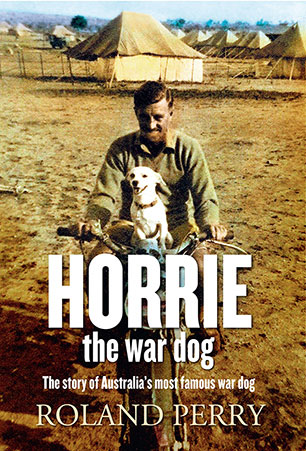This book is a re-telling of the story of Horrie, a stray Egyptian Terrier puppy, who was befriended in the Libyan desert by members of the Signals Platoon of the 2/1st Machine Gun Battalion, 6th Division, Australian Imperial Force, in 1941.

Ursula Davidson Library call number 580.2 PERR 2013
Horrie turned out to be an exceptional young dog. In the Western Desert, he proved to be an excellent guard dog, protecting the section that rescued him and their possessions from thieving Arab boys. In Greece, Crete and Palestine, his acute hearing enabled him to give early warning of approaching German ground-attack aircraft – early warning that saved countless Australian lives. His high intelligence allowed him to be trained to deliver messages by night over steep and dangerous terrain far quicker than any human could deliver then.
After Japan entered World War II in December 1941 starting a new front in the Pacific, 6th Division returned to Australia in early 1942 and Private Jim Moody, aided by his colleagues, smuggled Horrie back to Australia in breach of quarantine rules. Horrie’s war had now ended, but his human colleagues went on to serve in New Guinea until the end of 1944.
Horrie’s story was first told by Ion L. Idriess in his book Horrie the wog-dog: with the A.I.F. in Egypt, Greece, Crete and Palestine: written from the diary of Private VX13091 J. B. Moody A.I.F. (Angus and Robertson: Sydney; 1945). It ended with Horrie being surrendered to the health authorities in 1945 who put him down.
Perry’s new account says that is not what happened. Rather, Jim Moody substituted a similar-looking terrier for Horrie and it was the latter dog which Commonwealth health officials killed. Horrie went on to live an idyllic life on a dairy farm in northern Victoria for another 10 years.
Roland Perry is a renowned Australian author who has written several military books, including The Australian Light Horse and Monash: The Outsider Who Won a War. His style is somewhat akin to that of Peter FitzSimons – military history which can verge at the detailed level on historic fiction. In his ‘Acknowledge – ments’, he warns that the book “includes dramatisations and re-creations based on information from [his cited] sources” (p. 338). That limitation notwithstanding, the historic framework, if not always the detail, is accurate and it is a good, relaxing read.
Reviewed for RUSIV by David Leece
Contact Royal United Services Institute about this article.






